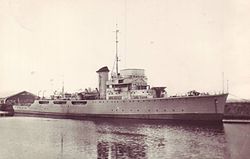Artevelde (ship, 1940)
|
Artevelde
|
||||||||||||||||||||||
|
||||||||||||||||||||||
|
||||||||||||||||||||||
|
||||||||||||||||||||||
|
||||||||||||||||||||||
The Artevelde was originally a fishery protection vessel designed single ship , whose construction started by the Belgian Marine Corps in 1939 and from the German Navy after the occupation of Belgium was completed in 1940 with a few changes. The ship served in the Second World War as a gunboat K 4 and then from 1945 to 1954 under its originally planned name Artevelde in the Belgian Navy .
Development and construction
Before the start of World War II, Belgium had only a very small fleet. The navy ("Korps der Zeelieden en Torpedisten") was disbanded in 1927 for reasons of cost, and it was not until 1939 that a small "Marine Corps" was created again in view of the German threat. Its fleet consisted mainly of the former German torpedo boats A 20 and A 43 of the First World War and the fishery protection ship Zinnia , a former British Sloop of Flower class . As a replacement for this ship, the Belgian government commissioned the fishing protection boat Artevelde from Cockerill in Hoboken (Antwerp) in 1939 . At the same time, the ship should serve the Belgian royal family as a state yacht and for this purpose also receive appropriate equipment.
The ship, laid in Kiel in 1939 and still under construction, fell into German hands in May 1940 during the occupation of Belgium on the slipway . Since the ship was about to be launched , it was decided to complete it under the provisional name Lorelei . After the launch on August 28, 1940, the shell was towed to Rotterdam and completed at Wilton-Fijenoord in Schiedam . Instead of the originally planned four 10.2 cm guns in double shields and one 20 mm twin flak , the ship was equipped with three 10.5 cm rapid-fire guns in single mounts , four 3.7 cm rapid-fire cannons and ten 20 -mm anti-aircraft guns armed. There were also mine racks and up to 120 mines . The work lasted until 1943, and it was not until April 25, 1943 that the ship, now classified as a gunboat and designated K 4 , was put into service by the Navy.
Technical specifications
The ship was 94.8 m ( waterline ) or 98.5 m ( Lüa ) long and 10.5 m wide, had a 3.8 m draft and displaced 1640 t (standard) / 2270 t (maximum). Only the gun shields were armored (40 mm). The machinery came from the United Kingdom and consisted of two Cockerill Babcock-Wilcox - boilers of 34 atmospheres and two sets of Parsons turbines , the two via a wheel gear screw drives of 2.6 m diameter. The power on the two shafts was 21,700 hp and the top speed was an impressive 28.5 knots . The bunker supply of 680 t of heating oil enabled a journey of 1200 nautical miles at a cruising speed of 19 knots. The crew consisted of 12 officers and 168 men. The ship was seaworthy and fast, but rolled considerably in rough seas .
use
Navy
The ship was assigned to the 1st barrier breaker flotilla and used in escort and watch service in the western North Sea and German Bight . On October 6, 1944, it was attacked by seven British motor torpedo boats (MTBs) during a security trip in the area of the West Frisian Islands , accompanied by the two minesweepers M 104 and M 201 . K 4 sank an MTB that exploded after a direct hit, and M 201 shot two more MTBs incapacitated. On the K 4 and M 104 , seven lightly wounded people were mourned after hits in the ship's side , bridge and chimney.
Belgian Navy
The boat survived the war undamaged, was returned to Belgium in 1945 and put into service by the Belgian Navy under its original name Artevelde as an escort and guard boat. From 1950 onwards it served as a school boat and houseboat . The ship was decommissioned on November 22, 1954 and then scrapped at J. Bakker & Zonen in Bruges .
Remarks
- ↑ It is also mentioned August 24, 1940.
- ↑ The Gusto NV shipyard in Schiedam is also mentioned occasionally.
- ↑ March 25, 1943 is also mentioned variously .
literature
- Erich Gröner , Dieter Jung, Martin Maass: The German warships 1815–1945; Volume 1 . Bernard & Graefe Verlag, Munich 1982, ISBN 3-7637-4800-8 (p. 174).
- Hans-H. Hildebrand, Albert Röhr, Hans-Otto Steinmetz: The German warships: Biographies - a mirror of naval history from 1815 to the present . 10 volumes, Köhler, Hamburg, ISBN 3836497433 , ISBN 978-3836497435 .
